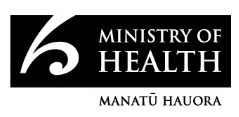
Document 1
MINUTES: COVID-19 Technical Advisory Group
Date:
Friday 28 January 2022
Time:
10.30 am – 12:00 pm
s 9(2)(k)
Location:
Chair:
Ian Town
ACT 1982
Anja Werno, Bryan Betty, Matire Harwood, Michael Baker, Nigel French, Nigel
Members:
Raymond, Sally Roberts, Shanika Perera, Virginia Hope
Ministry of Health Attendees:
Andi Shirtcliffe, Jeremy Tuohy, Cheriyse Hope
Guests:
Steve Waldegrave
INFORMATION
Apologies:
Collin Tukuitonga, Erasmus Smit, Caroline McElnay, Daniel Bernal, Emma
Hickson
Welcome and Previous Minutes
1.0
Dr Ian Town welcomed all members, attendees, and guests in his capacity as Chair of the COVID-
19 Technical Advisory Group.
Minutes of the last meeting (10 December 2021) were approved.
Ministry of Health Update on COVID-19 Outbreak Response
2.0
The Chair gave an update on the COVID-19 Outbreak Response:
•
Omicron is spreading in the community, and the cluster information gives a good indication
of some superspreading events e.g., the Soundsplash festival. So far, the public have
been very cooperative with public health measures. The origin of the outbreak has not
been identified, but WGS data suggests several incursions.
•
It was noted that BA.1 and BA.2 subvariants of Omicron do not appear to be different
clinically.
•
For modelling, a key driver in TPM model growth is the booster dose proportion. Gary
Jackson has a new forecasting model that looks at short term growth in cases and hospital
RELEASED UNDER THE OFFICIAL
admissions.
TAG feedback included:
•
The wedding in Auckland was large with guests from all over the country. Although there
has been very good cooperation from the group, it is unlikely that this cluster will be
controlled.
Document 1
• Model ing seems to indicate there may be a lot of hospitalisations, but overal cases are
milder. The main impact wil probably be on non-ICU hospital events and on primary care,
yet the focus has been on ICU beds. There are risks for both bed and staff availability.
• Older people (outside ARC) have had a high uptake of the COVID-19 vaccine. However, it
is important to emphasise they are stil at risk of poor outcomes if they get COVID-19,
otherwise there is a risk they may not seek appropriate care and potential y pass away at
home. In addition, in the context of the outbreak, older people may be less likely to seek
care for non-COVID-19 related il ness.
• Concerns were raised on how Māori and Pacific funding for immunisation and the covid
response was not available to services and community trusts not considered Māori or
Pacific providers, although they were providing for large number of high-risk Māori and
pacific patients. This was leading to concerns about funding streams and may in fact be
1982
disadvantaging some Māori Pacific communities serviced by non-Māori or Pacific
providers.
ACT
Traffic Light System Implementation
3.0
The Chair provided some brief comments on the ongoing implementation of the traffic light system.
However, the Omicron outbreak has impacted the settings for the system. Further discussion was
undertaken within the next item.
TAG feedback included:
• A concern was raised that the traffic light system may not be fit for purpose.
Response Strategy
INFORMATION
4.0
An overview of the Response Strategy was given:
• There are three stages depending on case numbers. The earliest stage is for containing
the virus, aiming to keep case numbers low due to equity and hospital capacity concerns.
When case numbers are high, the focus wil be on managing the system using digital
platforms and targeted support for the most vulnerable.
OFFICIAL
• The overal aim is to minimise hospitalisations and deaths, as well as manage equity since
certain groups wil be disproportionately affected.
THE
• The public wil experience the strategy differently, mainly through testing changes as the
public shifts from PCR testing to RATs. In large numbers, cases wil be self-managed,
upload their own RAT tests digital y, and isolation times wil decrease.
• The red traffic light decreases some superspreading events due to capacity limits (<100
UNDER
people indoors)
TAG feedback included:
• A member asked how other patient groups would be monitored to ensure they are not
affected e.g., oncology patients.
• A member asked if 10 days was too long to isolate, given that isolation times are reduced
overseas.
RELEASED
• A concern was raised about whether health workers need to be in isolation / away from
work for 10 to 14 days.
o The Ministry is looking at models for workers to be able to test to return to work,
given how infectious they are, that also minimises the risk of spreading SARS-
CoV-2.
Document 1
o Australia's supply chains suffered severely for a short period of time, so the
Ministry is working to prevent this.
• A member suggested that the frail / elderly should be added to the middle group (page 9)
since “over 60s” is too broad. Palliative care in the community should also be added – we
cannot assume people want to die in hospital. However, some palliative care services
have stated that they wil not see COVID-19 patients.
• A member noted that the traffic light system gives people the impression it is safe to meet
indoors at large gatherings if they have a vaccine pass. There is no mention of boosters.
This is a concern since young people were the last group to be vaccinated and will not be
getting their boosters for another 4 months. This is the demographic that wil be going to
these large events with a false sense of security, which wil accelerate the spread of
Omicron.
1982
o The first step towards fixing this is to change the definition of “ful y vaccinated” to
include the booster.
ACT
o A member suggested that “fully vaccinated” could also include the length of time
since the booster dose in the definition.
o A member noted the booster should be moved from 4 months to 3 months since
boosters are the single most effective measure for controlling the virus.
• A member expressed there was also a false sense of security around testing (PCR and
RATs). Sensitivities are particularly poor in first few days of infection, which most people
are probably not aware of.
o The chair stated an A3 has been developed to make this very clear.
INFORMATION
• A member raised concerns about equity when relying on digital tools through self-
management. Reliance on this could cause inequitable outcomes.
Science Updates
5.0
• It will be a while before the general extent of the difference between Omicron and Delta is
OFFICIAL
clear, but so far it is very clear that Omicron is less severe and more infectious than Delta.
• In regard to isolation times, there does not appear to be much difference between the
duration of infectiousnes
THE s between Delta and Omicron, but there is evidence that
vaccination influences time to a positive test and symptoms.
o A member noted that evidence shows that Omicron is cleared faster; viruses
generally increase either transmission or virulence.
UNDER
• A member asked whether there is emerging evidence showing that the combined oral and
nasal PCR test is better for confirming omicron.
o Not enough data for this yet but the testing team are looking at this.
o Moving to a different swab type would require more training and a lot more supply
of these swabs; better to keep to nasopharyngeal.
Māori Heal
RELEASED
th Perspectives
6.0
• A member noted that many concerns had already been addressed in this meeting.
• Access to masks has been an issue in South Auckland.
• There was a query around the ICU prioritisation tools update
Document 1
• This best sits with ICU doctors There is confusion about how to care for people in crowded
households. When Omicron is in the community / household should the advice be to “just
let it go” or isolate?
o Advice depends on living dynamics and any co-morbidities.
o Note that cannot necessarily stop the spread of Omicron in these settings even if
you want to
o Need to remember New Zealand stil has the Delta variant in the community which
tends to cause more severe illness – so the advice for community / household
needs to be different depending on the strain.
• A member asked whether we are stil using MIQ for some positive cases in the community.
o Regional hubs have been asked to provide advice about these contingencies for
1982
people at risk in unsuitable home arrangements; it is high on their agenda.
Pacific Health Perspectives
ACT
7.0
No update given.
Any Other Business
8.0
• A member noted MIQs have done outstandingly well, with no incursions despite large
numbers of the highly transmissible Omicron variant. The border remains a big risk and is
likely where Omicron came from.
• Regarding the push for people to wear particulate respirators, it was noted that we need to
reserve these for the front-line workers. INFORMATION
• A member noted there are challenges with therapeutics in the community, such as defining
who is at the highest risk. For example, treatment may need to be administered to 20-40
people to prevent one hospitalisation. Also, Paxlovid has many drug interactions and New
Zealand is getting access to Ronapreve just as Delta disappears. Community protocols are
being developed for the Care in the Community programme.
OFFICIAL
Agenda Items for Next Meeting
9.0
None noted
THE
New Action Items Raised During Meeting
10.0
None UNDER
Meeting closed at
11:47am Next meeting
25 February 2022
RELEASED
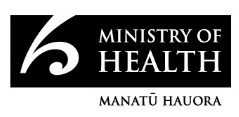
Document 2
MINUTES: COVID-19 Technical Advisory Group
Date:
Friday 25 February 2022
Time:
10.30 am – 12:00 pm
s 9(2)(k)
Location:
1982
Chair:
Ian Town
ACT
Bryan Betty, Erasmus Smit, Michael Baker, Nigel French, Nigel Raymond, Sally
Members:
Roberts, Shanika Perera, Virginia Hope
Ministry of Health Attendees:
Andi Shirtcliffe, Caroline McElnay, Daniel Bernal, Emma Hickson, Jeremy Tuohy
Guests:
Steve Waldegrave, Susan Morpeth
Apologies:
Anja Werno, Col in Tukuitonga, Matire Harwood
INFORMATION
Welcome and Previous Minutes
1.0
Dr Ian Town welcomed all members, attendees, and guests in his capacity as Chair of the COVID-
19 Technical Advisory Group. OFFICIAL
Minutes of the last meeting (28 January 2022) were approved.
Ministry of Health Update on COVID-19 Outbreak Response
THE
2.0
The Chair gave an update on the COVID-19 Outbreak Response:
•
the outbreak continues to be closely monitored, with infections now occurring within many
residential settings and a move to phase three of the Omicron response as signalled
UNDER
•
the focus of the response is now on protection of the health system, especial y with the
upcoming flu season, which wil add to the burden on the health system when coupled with
the Omicron wave
•
the National Immunisation Programme (NIP) wil be transitioning from the COVID-19
vaccination register to a general immunisation register (providing an improvement
compared with what is currently being used) which wil capture both publicly funded and
pr
RELEASED ivately administered vaccinations. This move will be beneficial as there is a wealth of
resources and knowledge that can be used for better monitoring and support.
•
The requirement for a booster to receive an updated vaccine pass is under consideration.
The technology exists to do this relatively quickly and smoothly, but this needs to be
addressed soon due to the deadlines of expiring vaccine passes.
•
the Director of Public Health noted that co-administration of the flu and COVID-19
vaccinations is being investigated, the current understanding being that they can and wil
Document 2
be received together. The flu vaccination rollout wil begin on 1 April 2022. Many important
lessons have been learnt from the COVID-19 vaccine rollout, which can be applied to
improve the flu vaccine strategy and implementation.
TAG feedback included:
• it was noted that the levels of anxiety amongst the public across the motu are rising,
putting pressure on Healthline and compromising ‘business as usual’. It was
recommended media is used to calm and reassure New Zealanders
• the possibility of reducing the isolation period for household contacts was raised, noting
that the response revolves around trying to titrate public health measures and societal and
public health pressures. It is possible that the long isolation times may be causing more
harm and discomfort than positive benefit
1982
• it was noted that the value of scanning QR codes is now doubtful, considering that close
contacts are not required to isolate and that the information is not being used
• it was noted that clearer communication of the plan for the next 2-3 months, particularly
ACT
with regards to the vaccination programme, may relieve some of the anxiety within the
public
• The Chair acknowledged that there seems to be some public concern surrounding the
notion of the potential need for additional booster doses
• It was flagged that the vaccination processes for the flu and COVID-19 vaccines are very
different, so in practice, co-administration may be challenging
• there was a concern raised that the beginning of the flu vaccine rol out may fal around the
INFORMATION
peak of the Omicron wave, which would put additional pressure on the health system
capacity and workforce
• there was a comment that the hospitalisation impacts of COVID-19 are difficult to
ascertain. This is not well measured by the number of people admitted as there is a lack of
differentiation between admission
with COVID-19 or
for COVID-19. This data would be
helpful, along with information regarding the comorbidities of admissions
OFFICIAL
• it was noted that work is needed to facilitate the uploading of RAT results.
• an issue was raised regarding the identification of high-risk events – these are currently
THE
identified by the sites rather than the event itself. If no official event is created or
registered, then it becomes challenging to identify people who are at high risk of having
been exposed. However, it was acknowledged that we are in a period of rapid transition
and changes must be carefully considered, to balance the speed of change of guidelines
and the frequenc
UNDER y with which changes are made
• a member noted that the emerging increase in case numbers in vaccinated (rather than
unvaccinated) individuals is likely confounded by the fact that a vaccinated person is more
likely to get a test and report their results. it was raised that a booster is required for
vaccine effectiveness against Omicron, and that this should be considered when
determining whether an individual is ‘fully vaccinated’ – such an update to the definition
would be wel supported by the science
RELEASED
• it was noted that Omicron displays immune escape from current vaccines, but booster
doses largely restore immunity. The evidence for the efficacy of vaccines in preventing
onward transmission is evolving.
• a member emphasised the importance of being able to defend the decisions, guidelines,
and allocation of resources during the COVID-19 response, which becomes easier when
they are supported by science
Document 2
RED Settings
3.0
The Chair provided an update on the current settings of the Omicron response:
• it was noted that the primary aim of the settings is to balance the practical response in an
effort to flatten the curve, while being conscious of the health system pressures. Currently,
a range of options are stil available to decrease the health burden of disease including
mask mandates, limits on gathering sizes, and vaccine mandates
• the future role of MIQ is also being reviewed.
TAG feedback included:
• there was also some discussion regarding the likely pattern of the outbreak after the initial
peak. It was recognised that the decrease from the peak may be slow or consist of multiple
peaks as it merges with winter influenza. Thus far there has been a focus on a ‘peak’ of
1982
the Omicron outbreak, but not much consideration around multiple peaks or the
emergence of new variants
ACT
• the burden of the Omicron outbreak is falling disproportionately on Pacific peoples, and
additional y the regional burden is disproportionate as well. It has become clear that those
that are highly deprived are more at risk, and therefore are more impacted. However, it
was noted that the high transmission events within these communities and subsequent
contact tracing may be contributing to over-representing this group. It is possible that a
change in the notification process may reduce this, e.g., a shift toward self-notification of
RAT results
• at the current settings, the number of community cases far outweighs the number of border
cases. Consideration should be given to whether the border settings sho
INFORMATION uld be adjusted
• there was a comment that the 3rd vaccination (‘booster’) is not expected to last much
longer than 3 months. Therefore, there may be another COVID-19 wave in winter
• there was a suggestion to consider taking the same approach to COVID-19 as flu
infections – adopting the mindset that people may have multiple infections throughout their
lives (though noting that the issue here may
OFFICIAL be a higher death rate, which would take a
number of years to bring down)
• a member asked if the negative RAT results were being collected with sufficient accuracy
THE
to enable a reliable denominator estimating test performance.
o The Chair noted that the extremely high number of cases during this initial wave
inevitably results in a “light touch” system without verification. However, people are
expected to notify both a positive and negative test result.
UNDER
Science Updates
4.0
No update given.
Māori Health Perspectives
5.0
No update given.
RELEASED
Pacific Health Perspectives
6.0
No update given.
Any Other Business
7.0
None noted.
Document 2
Agenda Items for Next Meeting
8.0
None raised.
New Action Items Raised During Meeting
9.0
None.
Meeting closed at
11:46am Next meeting
25 March 2022
1982
ACT
INFORMATION
OFFICIAL
THE
UNDER
RELEASED
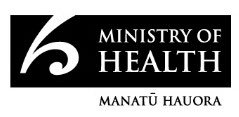
Document 3
MINUTES: COVID-19 Technical Advisory Group
Date:
Friday 25 March 2022
Time:
10.30 am – 11:30 pm
s 9(2)(k)
Location:
1982
Chair:
Ian Town
ACT
Anja Werno, Bryan Betty, Collin Tukuitonga, Erasmus Smit, Michael Baker, Nigel
Members:
French, Nigel Raymond, Sally Roberts, Virginia Hope
Ministry of Health Attendees:
Daniel Bernal, Emma Hickson, Jeremy Tuohy, Kayla Benjamin
Guests:
Aoife Kenny, Steve Waldegrave, Sarah Jefferies, Susan Morpeth, Alison Stringer
Apologies:
Matire Harwood, Shanika Perera, Andi Shirtcliffe, Caroline McElnay
INFORMATION
Welcome and Previous Minutes
1.0
Dr Ian Town welcomed all members, attendees, and guests in his capacity as Chair of the COVID-
19 Technical Advisory Group. OFFICIAL
Minutes of the last meeting (25 February 2022) were approved.
ESR Sentinel Surveil ance
THE
2.0
A proposal for a sentinel surveil ance system was presented. The importance of implementing and
maintaining a stable surveil ance system that can persevere in the face of emergent events in the
future was emphasised. With the border opening, resources need to be made available to
systematically sample for the detection of SARS-CoV-2, influenza, and other respiratory pathogens
UNDER
It was noted that the current surveil ance systems were seriously affected by the onset of the
pandemic. The aim of the proposed system is to implement a simple and accessible approach that
is as representative and equitable as possible, using the infrastructure that is already in place.
TAG feedback included:
RELEASED
•
Members were supportive of the proposed surveil ance system and commended the
initiative
•
It was noted that respiratory viruses wil be spreading slower within communities due to the
COVID-19 measures in place and thus it was queried whether this system will be
monitoring in real-time, noting this would depend on the sites that are doing the testing
o The aim is for the system to be as real-time as possible
•
A member queried whether this system was designed with public health policy in mind
Document 3
o The system is being designed to be robust and able to adapt to changes to public health
policy and emergent events
• Surveil ance systems are put in place to inform action both in the short-term response and
in the longer-term in the form of policy A member raised whether the primary function of
this system would be focused on informing a response to each case or on tracking the
distribution over time as these are different goals
• It was recommended that more thought be given to the populations that are going to be
sampled which would determine the site locations. For example, wil there be a focus on
high-risk populations or border populations?
o At present, sampling is restricted by the location of the local laboratories being used,
however, with time it can be identified where new sites are required to reach the certain
desired populations
o Emphasis was placed on the representativeness and equity in choosing the sampled
1982
populations
• The possibility of utilising enhanced wastewater testing was raised to determine the
sensitivity of the surveil ance testing in the sentinel sites
ACT
• A member noted that it would be helpful to have data linkage to work out who is at risk of
coming to harm in these populations which would inform hospitalisation risk of individuals
Traffic Light System Amendments, Vaccine Mandates and Passes
3.0
A presentation was given about the recent TLS amendments announced by the government and
the implications these may have on future case numbers and pandemic management. Different
areas of the country are experiencing their peak in case numbers at different times and in different
ways which is likely to lead to a long tale of case numbers across the country.
INFORMATION
While the case numbers have begun to drop there is a delay in this being reflected in
hospitalisation numbers. It is worth considering the possibility that due to the large proportion of
cases being in younger people thus far, there has been fewer hospitalisations, but as older and
more vulnerable communities have increased rates of infection, the rate of hospitalisation may
increase.
OFFICIAL
The importance and efficacy of booster vaccinations on transmission and hospitalisation was
il ustrated and the international evidence for the waning of immunity was raised.
THE
It was noted that the opening of the borders would expose the country to viruses that we have
been protected from for the last couple of years, which would combine with the seasonal winter
il nesses to put pressure on the public health system.
The direct impacts of the removal of the public health measures that were incorporated into the
UNDER
TLS likely includes increased transmission, however, this wil be difficult to ascertain as contact
tracing is no longer being undertaken. Over time, the increased immunity waning and reduced
vaccination adherence wil also contribute to increased transmission, particularly in vulnerable
populations. These factors have prompted the reassessment of the pandemic strategy, should the
focus be on reducing transmission as wel as severity? It was noted that other countries seem to
have a much more targeted approach, and that this may be where the targeted testing and
surveil ance strategies come into play.
RELEASED
TAG feedback included:
• A concern was raised about loosening the TLS guidelines instead of moving down a level
and that this approach may lead to a loss of trust in the system by the public. It was
recommended that the face validity of the system should be made more robust and then
adhered to without frequent adjustments or movement
Document 3
• Members recommended a greater emphasis be placed on equity. Consideration should be
given on how to strengthen the approach to caring for the most vulnerable, particularly with
this change in guideline and pandemic management
• It was noted that the increase in viral exposure following border opening wil pose a
complex problem as GP’s are currently operating at 15 to 30% over capacity in terms of
what they were this time last year. This relates to vulnerable patients not getting access to
the medical care that they require, an issue that has been noted throughout the pandemic.
It was urged that consideration be given to addressing deferred care in the next 12 months
and giving vulnerable patients the critical care that they have missed out on.
Vaccine Rollout
4.0
No update given.
1982
Pandemic Management
5.0
Members were asked to provide feedback on the Trends and Insights report that the Ministry
ACT
composes and publishes internally. Work is underway to make this report more widely available,
and feedback wil help shape what additional information is included.
• A member requested more guidance be given from the Ministry around the desired
PCR testing capacity retention in the event of a future variant arising
Surveil ance Strategy
6.0
An update on the wider surveil ance strategy was presented and members were asked for any
additional feedback. The Ministry is wanting to place more emphasis on targeted surveil ance in
INFORMATION
groups that are not currently using the public health system.
The Ministry is in the process of developing an external advisory group that wil utilize outside
expertise to both guide the strategy as wel as provide new input
TAG feedback included:
• It was noted that the surveil ance strategy that is used should be robust enough to keep up
OFFICIAL
with the dynamic nature of the pandemic response, and that this will likely need fresh
input/advice from external perspectives to keep the strategy fresh
o It was confirmed that the strategy was adapted and refreshed twice in the last
THE
year. The external group that is being developed wil assist in providing this advice
• It was requested that more focus be assigned to analysing the information around
disengaged patients – those that are not enrol ed in public healthcare. We should have
data to show where they are in the country, predominant age groups, ethnicity etc
UNDER
•
Science Updates
7.0
TAG members have been informed that the next Variants of Concern (VoC) wil be available on the
Ministry’s COVID-19: Science news page by Tuesday 29 March 2022.
RELEASED
Māori Health Perspectives
8.0
No update given.
Pacific Health Perspectives
9.0
No update given.
Document 3
Any Other Business
10.0
None.
Agenda Items for Next Meeting
11.0
None raised.
New Action Items Raised During Meeting
12.0
Meeting closed at
11:31am Next meeting
22 April 2022
1982
ACT
INFORMATION
OFFICIAL
THE
UNDER
RELEASED

Document 4
MINUTES: COVID-19 Technical Advisory Group
Date:
Friday 20 May 2022
Time:
10.30 am – 11:30 am
s 9(2)(k)
Location:
1982
Chair:
Ian Town
ACT
Members:
Bryan Betty, Michael Baker, Nigel Raymond, Sal y Roberts, Virginia Hope
Ministry of Health Attendees:
Andi Shirtcliffe, Daniel Bernal, Emma Hickson, Jeremy Tuohy, Frances Graham,
Kayla Benjamin, Sharon Sime
Guests:
Alison Stringer
INFORMATION
Apologies:
Erasmus Smit, Nigel French, Anja Werno, Collin Tukuitonga, Matire Harwood,
Shanika Perera, Jim Miller, James Entwisle, Jim Mil ar
Welcome and Previous Minutes
1.0
Dr Ian Town welcomed all members, attendees, and guests in his capacity as Chair of the COVID-19
OFFICIAL
Technical Advisory Group.
Minutes of the last meeting (25 March 2022) were approved.
THE
Variants of Concern Scenario Planning
2.0
A Ministry of Health attendee gave an update to TAG members regarding the Draft COVID-19 Variants of
Concern Document. This document sets out five planning scenarios that reflect the likely characteristics of
new variants and the approaches for each scenario.
UNDER
While the focus of the document is on the national-level response, the Ministry is actively engaging with a
wider range of stakeholders including Māori/Pacific providers, DHBs, clinical col eagues around operational
work.
TAG feedback included:
•
the reference to community organisations should be framed under a separate heading in addition to
Māori involvement in planning, governance and implementation. Community organisations captured
RELEASED
under this heading would include GP clinics, pharmacies, care in the community providers,
ambulance services etc
•
more emphasis is needed on the sustainability of NZ’s hospital workforce noting that there have
been reports of reduced capacity in some hospitals to account for COVID-related il ness. This has
been a critical challenge across all hospitals, community services as well as in laboratories
undertaking COVID related testing in response to the latest Omicron outbreak
1
Document 4
• the laboratory sector needs a profile particularly around infection/prevention control (eg, antimicrobial
resistance and emergence of other diseases such as monkey pox). Infection prevention/control
positions are critical to every hospital making this an important consideration in optimal recruitment
• risk assessment on variants is still missing within the context of long-term effects and impacts of
COVID (eg, reinfection).
ACTIONS:
• The Chair wil write to Health NZ, post the announcement of the leadership team in July, to express
concern about IPC in hospitals.
Science Updates
3.0
TAG members were informed that the next Variants of Concern (VoC) update wil be available on the
Ministry’s COVID-19: Science news page by Monday 23 May 2022. Members were advised that there has
1982
not been extra detection of sub lineages in the past three weeks (ie, not a significant change in the New
Zealand situation due to good links to WGS via ESR).
ACT
Trends and Insights Report
4.0
A copy of the
Trends and Insights Report produced by the Ministry’s Intelligence and Analytics team has
been included in the agenda for members information.
The purpose of this report is to provide a broad national and regional overview with key insights based on the
quantitative trends in the NZ COVID-19 epidemic including trends and scale of infection and diagnosis as
well as morbidity and mortality.
The Chair advised members that Science, Surveil ance & Insights Group (SS&I) have been working with
Stats NZ to develop an explainer about mortality data Definitions have been a key focus (
INFORMATION ie, providing clarity
in reporting those who died with verses those who died from COVID).
TAG feedback included:
• data visualisation is excellent (ie, graphs but absence of rates noted in some areas)
• hospitalisation is the one of the main measures of adverse health outcomes so reporting needs to
articulate what the drivers are that result in people bei
OFFICIAL ng admitted. For example, the Waikato DHB is
finalising a report (audit) commissioned by the Ministry (N=500) which focuses on drivers for COVID
related hospitalisations. THE
• antivirals and the need for them to be targeted is important (eg, low uptake of eligible individuals
receiving prescriptions). Concern was raised about the side-effects of antivirals (ie, are symptoms
associated with treatment being monitored).
Māori Health Perspectives
5.0
UNDER
The representative was not in attendance, so no update was given.
Pacific Health Perspectives
6.0
The representative was not in attendance, so no update was given.
Any Other Business
7.0 RELEASED
None raised.
Agenda Items for Next Meeting
8.0
None raised.
9.0
New Action Items Raised During Meeting
2
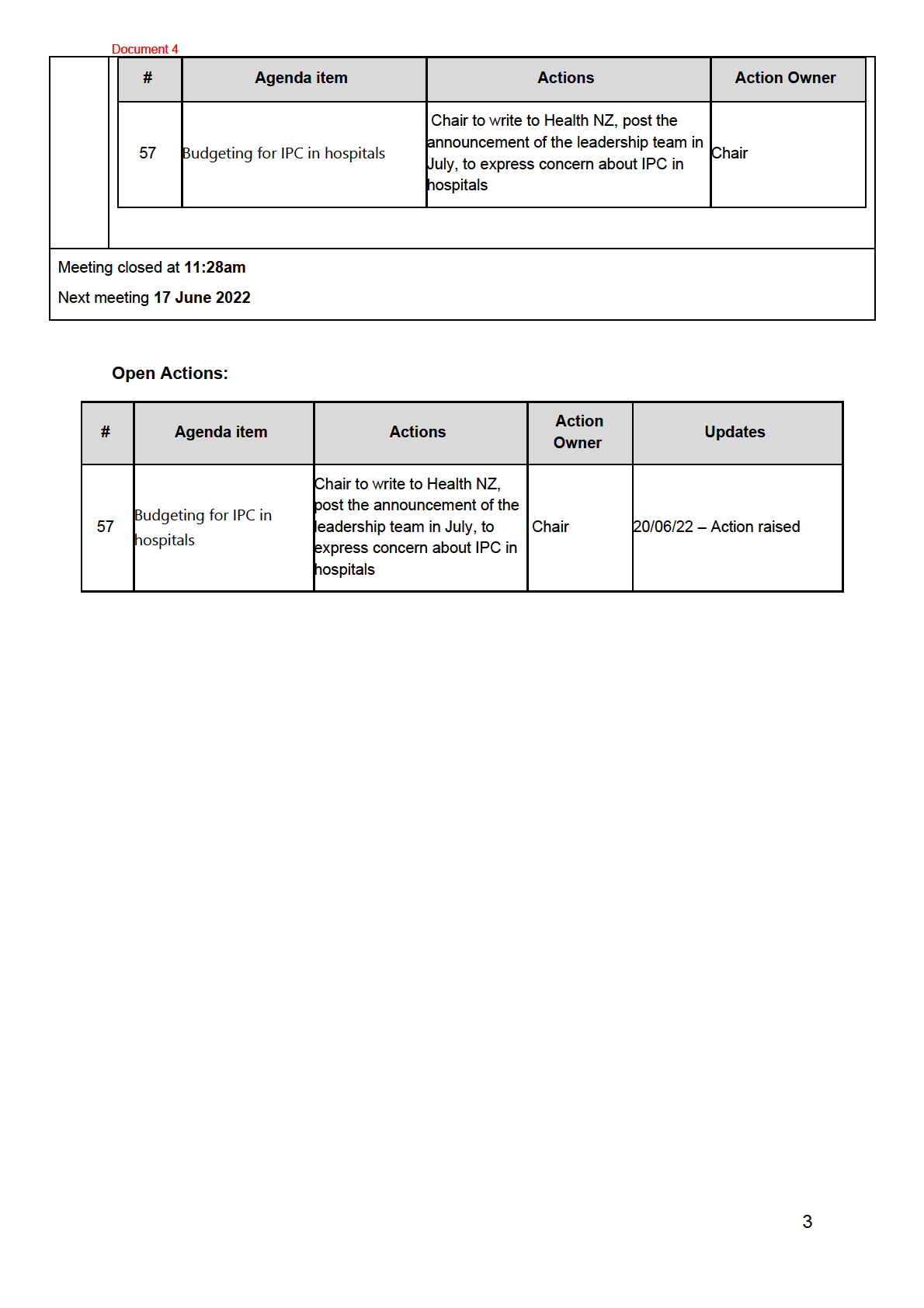
1982
ACT
INFORMATION
OFFICIAL
THE
UNDER
RELEASED
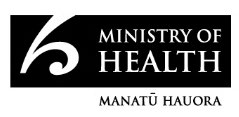
Document 5
MINUTES: COVID-19 Technical Advisory Group
Date:
Friday 17 June 2022
Time:
10.30 am – 11:30 am
s 9(2)(k)
Location:
1982
Chair:
Ian Town
ACT
Anja Werno, Bryan Betty, Erasmus Smit, Michael Baker, Nigel French, Nigel
Members:
Raymond, Sally Roberts, Virginia Hope
Ministry of Health Attendees:
Daniel Bernal, Emma Hickson, Euan Russel , Harriette Carr, Kayla Benjamin, Pete
Hanl
Guests:
Cat Edwards, Michelle Balm, Antoinette Righarts
INFORMATION
Apologies:
Andi Shirtcliffe, Collin Tukuitonga, Jim Miller, Jeremy Tuohy, Matire Harwood,
Shanika Perera
Welcome and Previous Minutes
1.0
OFFICIAL
Dr Ian Town welcomed all members, attendees, and guests in his capacity as Chair of the COVID-
19 Technical Advisory Group. The Chair congratulated Sir Col in Tukuitonga on his knighthood and
Bryan Betty as a recipient of this year’s New Zealand Operational Service Medal.
THE
Minutes of the last meeting (20 May 2022) were approved.
Wastewater Based Epidemiology 12-month Plan
2.0
A Ministry employee presented the wastewater-based epidemiology (WBE) plan to assess value
UNDER
from a science-led perspective. The plan wil go to the DG beginning of week 20 June.
ESR (Institute of Environmental Science and Research) and Nigel French (Massey University)
declared a conflict of interest.
TAG feedback included:
•
The need for increased monitoring of particular pathogens
o Antimicrobial resistance (AMR) genes were mentioned by several members – they
RELEASED should be monitored, if possible, given their likely introduction due to opening
borders; currently only measured at hospitals, not community level
o Carbapenem-resistant gram-negative bacteria are also of particular concern
•
The paper should be clearer on describing the purpose and practical implications of WBE,
including:
o What decision will be informed by this data?
o How can WBE be used for RSV?
1
Document 5
o How can WBE be used as a surveil ance tool and integrated with other tools?
o What could we do with it in the future?
• The need for sketching out usefulness and limitations of WBE including:
o Pathogens listed for further testing require a feasibility study to determine how
useful the data would be (e.g., influenza and RSV are shed at rather low rates and
therefore may not yield useful results)
o Needing to understand coverage, particularly in reaching priority populations. One
mil ion people in NZ are not connected to reticulated wastewater systems which is
important to consider when interpreting results
o WBE might not give a useful indication with regards to community-transmission
(positive result could be linked to tourists passing through). Consideration needed
as to how WBE can change the management of community outbreaks
o Whether WBE can be used for early warning to indicate where viruses are 1982
beginning to circulate (such as influenza and RSV)
• Need for validation: normalising of wastewater catchments to population and relative case
numbers, duration of infectiousness and period of shedding (latent period)
ACT
• Incorporate lessons from COVID-19
o The approach needs to consider new variants, such as rapidly developing sensitive
and specific assays in a timely manner (good system with COVID-19, and it needs
to be impeccable and practical)
o There needs to be more exploration into what WBE can do using quantification.
Critical role of WBE during the elimination stage, but harder to understand the value
now (particularly absence/presence) with high case levels of COVID-19
• Re-examination of methods
o NZ is out of step with Australia’s approach to focus on metropolitan areas and few
INFORMATION
rural sites. Consideration needed as to whether fewer sites but more in-depth
testing would be more useful than a scattered approach
• The need for an Infection prevalence survey (although self-reported testing fatigue might set
in) al owing for more direct variables to be captured
OFFICIAL
Surveil ance – Proposed Surveys
3.0
The Chair gave a verbal update on the proposed infection and seroprevalence survey, both close to
THE
being finalised.
For the infection survey, a decision has been made to use the New Zealand Health survey platform,
an existing framework that can be readily implemented and is more cost-effective for the Ministry.
Recruitment wil be extended to priority populations, wider geographic areas, Māori and Pacific
UNDER
peoples to increase the number of participants and enable real time information.
Statisticians are currently finetuning the group to be surveyed.
Decisions regarding numbers and costing are under consideration. Once these are approved the
infection study wil be underway.
RELEASED
2
Document 5
Reinfection Guidance
4.0
The memo “COVID-19 ‘New Infection’ Guidance Testing Options for those with a suspected New
and/or Reinfection with COVID-19” was shared with the TAG members prior to the meeting for
discussion.
TAG feedback included:
• Retest should be more pronounced: false positives can become an issue when prevalence
is dropping and there is now good evidence to show repeat RATs could help counter this
effect
• Re-positive tests within 28 days in a DHB setting could be problematic, however, DHBs
have existing guidance and protocols to support this.
• Genome sequencing can be very helpful to confirm whether the infection is a repeat
1982
infection (e.g. if it is a new variant)
• Immunocompromised groups with persistent infection should be ruled out
Re-testing needs to be spel ed out; clauses need to be included to avoid a rigid interpretation.
ACT
Note: STA to consult as needed with the Ministry’s COVID-19 Clinical Oversight Group (COG) on
whether DHB’s protocol aligns with this guidance to enable ongoing operation and appropriate
recognition of reinfection.
Science Updates
5.0
Proportions of BA.4, BA.5 and BA.2.12.1. are increasing. A previous infection with BA.1. doesn’t
provide as much protection as BA.2 against the emerging sub-variants.
TAG feedback included:
INFORMATION
• Model ing suggests that BA.5 wil become the dominant variant in NZ in late July (doubling
time of cases being 5-14 days)
• Inequitable access: Care for COVID-19 has been funded unlike similar symptoms stemming
from other winter il nesses which end up putting pressure on emergency departments (e.g.,
respiratory viral testing) OFFICIAL
• Suggestion to publish more information on variant tracking on the Ministry’s website. Plain
English explanations would be helpful with regards to mortality and excess mortality (be
clear what can be attributed to COVID-19)
THE
• The Chair noted the feedback and added that there are several ‘deeper dives’ into mortality
currently occurring. One of these is being presented to the next Strategic Public Health
Advisory Group on 29 June.
• Circulating viruses, especial y influenza, are adding pressure on primary care and hospitals
UNDER
ACTION:
• Chair to fol ow up regarding funding across COVID-19 versus non-COVID-19 influence-like
il nesses.
Trends and Insights Report
6.0
The latest report from 10 June 2022 has been circulated prior to the meeting.
RELEASED
TAG feedback included:
• We can no longer keep new variants out, but more focus is needed on how the spread can
be delayed
• Concerns regarding the abolishment of pre-departure testing, particularly given 2% of
arrivals have recorded positive RATs
3
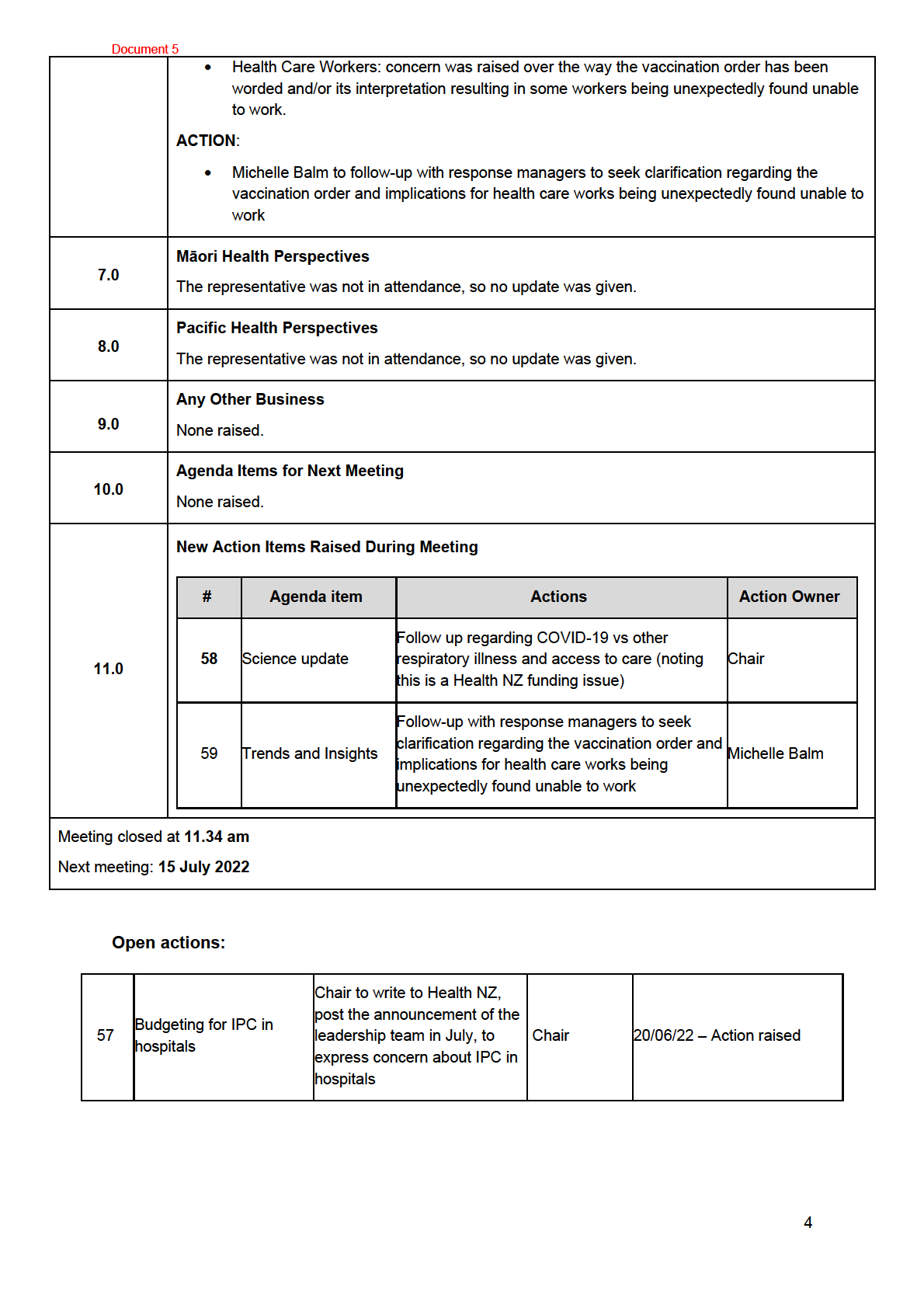
1982
ACT
INFORMATION
OFFICIAL
THE
UNDER
RELEASED
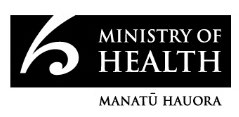
Document 6
MINUTES: COVID-19 Technical Advisory Group
Date:
Friday 15 July 2022
Time:
10.30 am – 11:30 am
s 9(2)(k)
Location:
1982
Chair:
Ian Town
ACT
Anja Werno, Bryan Betty, Erasmus Smit, Michael Baker, Michel e Balm, Nigel
Members:
French, Nigel Raymond, Virginia Hope
Ministry of Health Attendees:
Daniel Bernal, Harriette Carr, Jeremy Tuohy, Kayla Benjamin
Guests:
Fiona Cal aghan
INFORMATION
Apologies:
Andi Shirtcliffe, Claire Whelen, Collin Tukuitonga, Emma Hickson, Matire
Harwood, Sally Roberts, Shanika Perera
Welcome and Previous Minutes
1.0
Dr Ian Town welcomed all members, attendees, and guests in his capacity as Chair of the COVID-19
OFFICIAL
Technical Advisory Group.
Minutes of the last meeting (17 June 2022) were approved.
THE
Update on the pandemic response
2.0
The Chair gave a summary of the restructure of the Ministry of Health and the COVID-19 directorate:
Many of the roles within the COVID-19 response have moved into Health New Zealand. The Public Health
Agency (PHA) sits within the Ministry and Dr Andrew Old has been appointed to the role of Deputy
UNDER
Director-General (DDG). The new director of public health is Dr Nick Jones. The Intelligence, Surveil ance
and Knowledge (ISK) group is a fundamental part of the PHA.
TAG feedback included:
•
A member asked for clarification around how TAG feedback wil be addressed and fed into the
wider system.
o The members were assured that their advice and feedback wil stil be appropriately
RELEASED addressed and fed through to the strong leadership within the PHA retained from the
COVID-19 directorate.
•
The Chair noted that a discussion is being progressed with new DDG about the future direction of
TAGs.
•
It was raised that IPC needs to have a place in planning and should not be forgotten.
•
It was noted that the Infectious Diseases Network could be engaged in a more coherent way and
it should be explored how this can be utilized to respond to other emerging infectious diseases.
1
Document 6
ACTION: Chair to invite the PHA DDG to attend next meeting to discuss the role of TAGs within the
Ministry
Winter Measures Health Report
3.0
The data currently shows NZ is experiencing a sharp rise in BA.5 infections/cases.
A winter measures health report was presented by a ministry guest. Key points from presentation were:
• wastewater results show we may be under-reporting cases by up to 50%
• the eligibility for second booster is currently being reviewed
• almost 1 mil ion eligible New Zealanders have not yet had their first booster
TAG feedback included:
There was a discussion surrounding the concerns and benefits of pharmacists providing antiviral 1982
medicines for COVID-19 patients.
• Concern from rural health and prescribing pharmacists whether the system can safely undertake
ACT
pharmacy prescription of COVID-19 treatments.
• This response and advice involved in increasing the availability of therapeutics for COVID-19
seems rushed and it was noted that more extensive consultation should have been undertaken.
• Therapeutics TAG are supportive of the wider access criteria that have been announced,
particularly for the elderly. It was noted that working out the risk of hospitalisation due to Omicron
infection has become much more difficult with the high vaccination rates within NZ. The benefit is
felt in elderly over 80.
• In rural areas, pharmacies are usual y much more available than a GP, making access to these
treatments more equitable in these regions.
INFORMATION
• It was noted that there is a robust training process and the need to act quickly, in addition to
reducing the risk of hospitalisation, outweighs the risks of poor outcomes
Regarding Ventilation
• A member noted that when it comes to reducing transmission, ventilation is a great strategy but
takes a long time to implement, particularly in winter. It was raised that the education sector is
OFFICIAL
critical when it comes to mask wearing and it was questioned whether the exclusion of mandating
masks in schools in this report is a missed opportunity.
• It was noted that there was feedback from the Ministry of Education that the mandating of masks
THE
in schools is not without consequences within education, for example, engagement from students
is reduced, students with hearing disabilities and students for whom English is a second language
are particularly impacted due to the lack of visual clues, and specific subjects like drama and
dance are particularly impacted by mask use.
• It was also noted that on wet days, students often eat and spend lunch time inside without masks
UNDER
on but are asked to wear masks during class time in the same room which is contradictory,
particularly for younger children.
• It was raised that we are in the midst of an environmental crises just as much as a health crises
and disposable masks are not helping the environment and it is potentially not widely enough
known that masks can be washed repeatedly without impacting the effectiveness.
• Regarding increasing mask use and noting the logistical difficulty with policing mask use, the
question was raised whether mandating is the most effective course of action to increase use.
RELEASED
Encouraging positive use of masks and reiterating the team of 5 mil ion mindset rather than to
reintroduce mandates may have a better result.
VoC Threat Assessment
4.0
A presentation was shared regarding BA.4/5. The severity and hospitalisation risk is still largely unknown.
2
Document 6
TAG feedback included:
• It was noted that over 50% of cases are now a combination of BA.4 and BA.5.
• It was noted that the subvariant BA.2.75 has been identified in India but that it is unlikely to
become as prominent in New Zealand as it is competing with BA.4 and BA.5 whereas in India,
BA.2.75 is competing against BA.2.
• The Chair noted that ICU admission rate is low, more people are in hospital with influenza than
with COVID-19.
• The Chair later noted that the Variants of Concern plan included one scenario of a variant that had
a much more severe clinical impact.
Science Updates
5.0
The latest SARS-CoV-2 Variants of Concern update dated 7 July 2022 was circulated with members and
1982
attendees for their information.
Trends and Insights Report
ACT
6.0
The latest report dated 8 July 2022 was circulated with members and attendees for their information.
TAG feedback included:
• Regarding the number of deaths reported, it was noted that work continues to improve data
collection for deaths due to COVID-19 and deaths with COVID-19. A small number of deaths in
the community were not accounted for in the total number of deaths in the country but that is
being fixed currently which wil lead to a further change in the way the Ministry reports deaths.
• There was strong support from the members regarding increased transparency and improved data
quality.
INFORMATION
Māori Health Perspectives
7.0
The representative was not in attendance, so no update was given.
Pacific Health Perspectives
8.0
OFFICIAL
The representative was not in attendance, so no update was given.
Any Other Business
THE
It was raised that COVID-19 is not the only infectious disease that poses a significant health risk and
whether there is an opportunity to build on testing for COVID-19 and to expand the testing to include other
infectious disease (including influenza) in the long-term so that therapies could be more accurately
targeted.
UNDER
9.0
It was noted that the meningococcal cases in Northland which have tested positive for influenza creating a
false impression that influenza was the underlying cause of il ness.
It was raised that COVID-19 is being prioritised for treatment and funding which is negatively impacting the
recognition and treatment of other viral il nesses.
It was noted that some Districts have already moved from COVID-19 committees to winter virus
committees to adequately address the impacts that other winter il nesses are having on the system.
RELEASED
Agenda Items for Next Meeting
10.0
None raised.
3

1982
ACT
INFORMATION
OFFICIAL
THE
UNDER
RELEASED
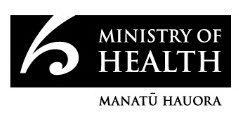
Document 7
MINUTES: COVID-19 Technical Advisory Group
Date:
Friday 12 August 2022
Time:
10.30 am – 11:30 am
s 9(2)(k)
Location:
1982
Chair:
Ian Town
ACT
Anja Werno, Erasmus Smit, Michael Baker, Michelle Balm, Nigel French, Sally
Members:
Roberts, Virginia Hope
Ministry of Health Attendees:
Andi Shirtcliffe, Daniel Bernal, Harriette Carr, Jeremy Tuohy, Kayla Benjamin,
Pete Hanl
Guests:
Andrew Old, Fiona Callaghan, Maria Cotter, Seamus Brady
INFORMATION
Apologies:
Bryan Betty, Collin Tukuitonga, Matire Harwood, Nigel Raymond, Shanika Perera
1.0
Welcome and Previous Minutes
Dr Ian Town welcomed all members, attendees, and guests in his capacity as Chair of the COVID-19
OFFICIAL
Technical Advisory Group.
Minutes of the last meeting (15 July 2022) were approved subject to the fol owing amendments (in italics) on
item
9.0 Any Other Business; THE
‘It was raised that COVID-19 is being prioritised for treatment and funding which is negatively impacting the
recognition and treatment of
other il nesses and health outcomes, to an unknown degree.’
2.0
Round of introductions – DDG PHA
UNDER
The Chair welcomed and introduced Dr Andrew Old, the recently appointed Deputy Director-General of the
Public Health Agency (PHA). Dr Old was welcomed by the TAG members, many of whom he has worked
with over the years.
3.0
Future of TAG
The Chair reiterated the important role the COVID-19 TAG has played throughout the pandemic, the value
placed by the Mins
RELEASED ters on the guidance and collective wisdom of the group and the anticipation that the
group would continue to fulfil its current role.
4.0
Outbreak Strategy
A presentation of the direction of the Outbreak Strategy was provided by Ministry of Health officials. The four
principles guiding the strategy were described as fol ows:
1
Document 7
• to reduce the mandatory public health measures where necessary to ensure public health
interventions were proportionate
• to rely upon voluntary measures to reduce the impact of COVID-19
• to remain vigilant and be prepared
• to manage COVID-19 as other infectious diseases are managed.
The aim is therefore to integrate the management of COVID-19 into the “BAU” of the healthcare system.
TAG feedback included
• Mandating some measures (e.g., masks), ensures that those most vulnerable are protected in
public.
• It was emphasised that mask wearing does not have just a personal impact but is a behaviour which
can impact other individuals. Therefore, these public health measures can be placed into the same
category as behaviour on the roads, which is regulated to ensure safety for al .
1982
• It is necessary to think beyond COVID-19 to manage the healthcare system effectively.
• The future impact of COVID-19 on the community is not clear and wil be strongly influenced by the
emergence of new variants. In addition, it is increasingly difficult to predict the impact of n
ACT ew
variants on the New Zealand population for a range of reasons.
The Chair responded that the management of waves of infectious disease is not a new problem, but one
that the health system must deal with. Although there are multiple measures which can be used to assess
the impact of COVID-19 or other il nesses on the health service, it is very difficult to identify a single
threshold at which to introduce, or re-introduce public health measures.
5.0
Infection/Seroprevalence Surveys
A Ministry of Health Official presented a verbal overview of the current state of the survey, which is now at
INFORMATION
the end of design and testing state and is with the Ethics Committee.
The three objectives include Testing (PCR), seroprevalence and questionnaires. Individuals wil be invited to
be involved in any or all of these three facets.
TAG feedback included:
OFFICIAL
• Members enquired whether the samples wil provide information for other diseases
The Ministry official replied that the draft survey is stil under review by an epidemiologist to ensure that the
incidence and prevalence data was robust and that testing for other conditions in addition to COVID-19 is in
THE
the protocol.
6.0
Mortality Review
The PHA, within Manatū Hauora, are conducting an analysis of the mortality risk by ethnicity, comorbidities,
UNDER
age, vaccination, and other factors. This work wil be peer-reviewed by external academics, and made
publicly available on the Ministry’s website, in order to inform, and provide context for the other mortality
data statistics.
TAG feedback included:
• The group endorsed the value of this work.
RELEASED
7.0
Science Updates
The latest SARS-CoV-2 Variants of Concern (VOC) update dated 28 July 2022 was circulated with
members and attendees for their information.
A Ministry official informed the group that the VOC document is being revised to improve readability. This
has been necessary due to the large accumulation of information collated into this document. The key
message from the VOC is that there has been the continued emergence of new variants, which have arrived
2
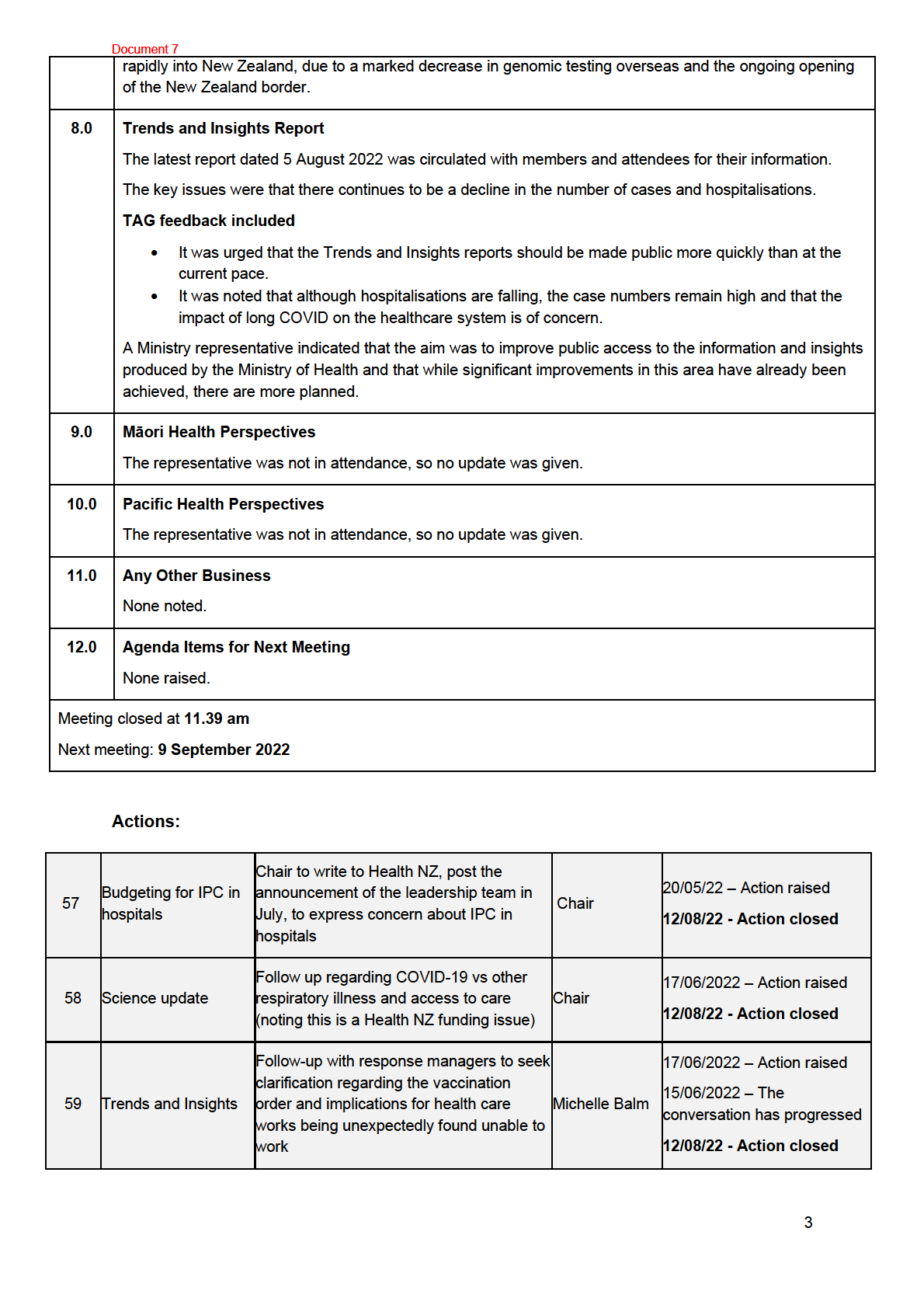
1982
ACT
INFORMATION
OFFICIAL
THE
UNDER
RELEASED
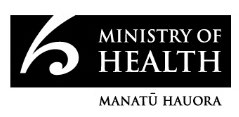
Document 8
MINUTES: COVID-19 Technical Advisory Group
Date:
Friday 9 September 2022
Time:
10.30 am – 11:30 am
s 9(2)(k)
Location:
1982
Chair:
Ian Town
ACT
Anja Werno, Bryan Betty, Erasmus Smit, Michael Baker, Michel e Balm, Nigel
Members:
French, Nigel Raymond, Virginia Hope
Ministry of Health Attendees:
Andi Shirtcliffe, Daniel Bernal, Euan Russel , Harriette Carr, Jeremy Tuohy, Kayla
Benjamin, Nicholas Jones
Guests:
Antoinette Righarts, Stephen Glover
INFORMATION
Apologies:
Andrew Old, Col in Tukuitonga, Matire Harwood, Sally Roberts, Shanika Perera
1.0
Welcome and Previous Minutes
Dr Ian Town welcomed all members, attendees, and guests in his capacity as Chair of the COVID-19
OFFICIAL
Technical Advisory Group.
Minutes of the last meeting (12 August 2022) were approved.
THE
2.0
CPF Adaption Update
A representative from Policy presented proposed COVID policy guidelines developed with DPMC.
Guidelines proposed to Cabinet, were largely centred around removing the majority of COVID controls.
UNDER
Policy noted that traffic light system has served its purpose and that with relatively high levels of population
immunity from a combination of vaccination and infection rates, it is an appropriate time to consider a future
system.
Future COVID guidelines wil manage COVID-19 like other infectious diseases and rely on good voluntary
compliance and ability to increase restrictions and add layers as required/needed. Key principles of strategy
to be maintain stability, be protective, resilient, and an emphasis on being prepared.
TAG feedback in
RELEASED
cluded
•
Members of TAG commented that changes to the guidelines were sensible given the current stage
of the pandemic and that this is the time to enshrine legacy benefits from the COVID response by
systematically communicating risk to public.
•
Comments on shifting behaviours from mandate to culture which wil yield a better ‘normal’ with
respect to other infectious diseases.
1
Document 8
3.0
Infection/Seroprevalence Surveys
• The Chair commented that proposed infection survey is due to get underway. Feedback on the
written protocol was welcomed by email.
• TAG members commented that it would be beneficial to strengthen and expand use of New
Zealand Health Survey rather than doing repeated surveys. This would also open opportunities to
investigate long-COVID and other COVID related questions.
4.0
Science Updates
The latest SARS-CoV-2 Variants of Concern (VOC) update dated 19 August 2022 was circulated with
members and attendees for their information.
• A representative from STA gave a brief overview of updates and changes to the VoC.
1982
5.0
Trends and Insights Report
The latest report dated 2 September 2022 was circulated with members and attendees for their information.
ACT
A representative from Intelligence, Surveil ance and Knowledge (ISK), gave a brief overview of the key
trends.
The key updates were consistent decreases across all case metrics and wastewater. Cases are tracking
well against the predicted model. Deaths are declining in elderly and all ethnicities, including Pacific people.
6.0
Mortality Report Findings
A representative from ISK gave a brief overview of the draft mortality report. An external reviewer has
provided feedback and report wil be made public in the coming weeks. It was noted that throughout the
INFORMATION
pandemic, we are unsure how effectively the public have understood the impact age and vaccination status
have on risk so mortality report could help to highlight this further to promote the benefits of vaccination.
The key themes were Māori and Pacific people have higher mortality risk, independent of age. After
accounting for vaccination, risk of death is halved if people have had at least two doses of the vaccine. Co-
morbidities represented highest risk factor for those under the age of 60.
OFFICIAL
Next report wil be on hospitalisation.
TAG feedback included:
THE
• Recommended presenting draft report to Therapeutics TAG.
• Members commented that biggest modifier was vaccination and this should be clearly
communicated wider to the public as it is in the New Zealand context.
• Members also commented likely some deaths are missed. Many deaths caused by circulatory
issues wil be COVID-ass
UNDER ociated. Also noted that elderly COVID-associated deaths usually present
with delirium before progressing.
• Members would appreciate a comparison of mortality risk to other countries.
7.0
Future of COVID-19 TAG and Incoming Chair
The Chair (Dr Ian Town) formally announced the transition of Chair to Dr Nicholas Jones.
Dr Town paid tribute to STA and commented that he has moved to the Research and Innovation Directorate
RELEASED
of the Ministry as part of the Health Reforms.
Dr Town also thanked al members of the TAG for their very valuable contributions throughout the
pandemic.
8.0
Māori Health Perspectives
The representative was not in attendance, so no update was given.
2
Document 8
9.0
Pacific Health Perspectives
The representative was not in attendance, so no update was given.
10.0 Any Other Business
None noted.
11.0 Agenda Items for Next Meeting
None raised.
Meeting closed at
11.52 am Next meeting:
7 October 2022
1982
ACT
INFORMATION
OFFICIAL
THE
UNDER
RELEASED
3











